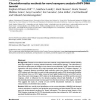Free Online Productivity Tools
i2Speak
i2Symbol
i2OCR
iTex2Img
iWeb2Print
iWeb2Shot
i2Type
iPdf2Split
iPdf2Merge
i2Bopomofo
i2Arabic
i2Style
i2Image
i2PDF
iLatex2Rtf
Sci2ools
97
Voted
BMCBI
2006
2006
Cheminformatics methods for novel nanopore analysis of HIV DNA termini
Background: Channel current feature extraction methods, using Hidden Markov Models (HMMs) have been designed for tracking individual-molecule conformational changes. This information is derived from observation of changes in ionic channel current blockade "signal" upon that molecule's interaction with (and occlusion of) a single nanometer-scale channel in a "nanopore detector". In effect, a nanopore detector transduces single molecule events into channel current blockades. HMM analysis tools described are used to help systematically explore DNA dinucleotide flexibility, with particular focus on HIV's highly conserved (and highly flexible/reactive) viral DNA termini. One of the most critical stages in HIV's attack is the binding between viral DNA and the retroviral integrase, which is influenced by the dynamic-coupling induced high flexibility of a CA/TG dinucleotide positioned precisely two base-pairs from the blunt terminus of the duplex viral DNA. ...
| Added | 10 Dec 2010 |
| Updated | 10 Dec 2010 |
| Type | Journal |
| Year | 2006 |
| Where | BMCBI |
| Authors | Stephen Winters-Hilt, Matthew Landry, Mark Akeson, Maria Tanase, Iftekhar Amin, Amy Coombs, Eric Morales, John Millet, Carl Baribault, Srikanth Sendamangalam |
Comments (0)

